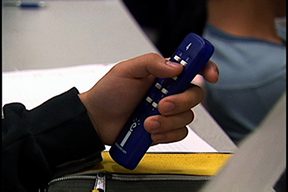Clickers (or classroom performance system) are wireless response pads used by students to provide teachers and students with immediate feedback on quizzes and polls. A series of questions is projected on a screen, then students reply (often anonymously). Their selections are captured, and the distribution of answers to each question is projected on the screen and recorded in the application for further analysis.

Preparing questions
Developing good questions is a key to success with clickers, so instructors should expect to spend some time thinking about, writing, editing, and sequencing questions. An Instructional Development Consultant can help with the process of developing effective new questions and offer feedback on existing questions.
Create clicker questions for different stages of a topic or lesson. You can ask questions to gauge students’ prior knowledge on a topic area, to get a sense of their understanding of specific concepts along the way, or to review material prior to an upcoming test or exam.
Create clicker questions to assess different levels of learning. There are different models for how to implement clicker questions into a classroom. One approach is to start with 1 or 2 factual or recall questions, then move onto other questions that require application of concepts, and finally require higher critical thinking. Another approach is to intersperse clicker questions among lecture topics. For example, ask 3 clicker questions every 30 minutes or so. Other approaches can be found in the resources below.
Administering quizzes
Give students time to think. When using clickers to present new material, students need extra time to reflect and develop their responses. It may be advisable not to use the timer in the first few lessons.
Encourage students to collaborate. To maximize opportunities for student collaboration, you should encourage students to exchange ideas and opinions about the question before they respond using the clickers. Alternatively, you may have a number of students share a clicker. In this way, they will have to collaborate with their partner(s) in order to form a response.
Keep them in suspense! If the results show that students chose all the answer options relatively equally, you can ask students to go back and redo the question without revealing the correct answer (this depends on the feedback settings you have selected). This approach can stimulate a lot of discussion, so this lends itself well to being a small group activity. Hopefully the next time students select their answers using the clickers, more of them will select the correct answer. If not, it’s still valuable information for the instructor!
Stimulate discussion using polls.You can even create questions for which there may be no ‘right’ answer. In such cases, you can use the clickers to poll students’ responses in order to stimulate discussion and raise awareness of a particular issue, or to give you a sense of particular interests or perceptions.
More information
- Using a Personal Response System (Clickers) in Economics Teaching.
- Clicker Resource Guide [PDF].
- Turning Technologies is the Clickers software that BCIT is using.
- For all questions about Clickers, please call the Educational Technology Services Help Desk at 604-714-7444 (option 2).